In December 2021, the family of the author watched the launch of NASA’s James Webb Space Telescope (JWST), a significant advance in telescope technology since the Hubble. The Webb telescope successfully navigated numerous potential failures and, six months post-launch, captured its first images of distant galaxies.
A key feature of JWST, the Aperture Masking Interferometry (AMI), designed by Australian astronomer Peter Tuthill, allows for enhanced resolution by plugging a precision piece of metal into the telescope’s camera. The AMI is crucial for diagnosing blurriness caused by nanometer-level distortions in Webb’s mirrors.
As the team prepared to observe celestial bodies, they discovered unexpected blurriness in images due to electronic effects impacting data quality. This issue was more severe than anticipated and required a solution.
University of Sydney PhD student Louis Dedowacz developed a model combining optical simulations with machine learning to correct these distortions. This led to clearer observations of stars and planets around HD 206893, including a faint dark planet and brown dwarf. Another study focused on Jupiter’s moon Io, revealing its volcanoes in a timelapse and confirming observations of black hole jets. AMI’s new capabilities promise to enhance the exploration of planets and contribute to future astronomical technology, paving the way for discoveries of Earth-like planets beyond our galaxy.
Source link


